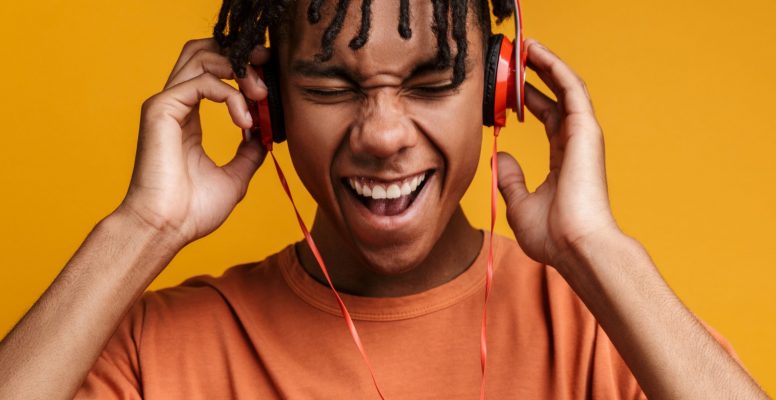
The Rock and Role of Music in Adolescent Development: Exploring the Benefits of Listening to Music for Adolescent Development
Written By: Sarah Hulscher, Clinical Trainee at ACS, On-Campus Counseling Program
NEARLY EVERYcoming-of-age movie involves a scene with a teen protagonist listening to some of their favorite music way too loud. Often, these favorite songs aren’t appreciated by the parents of the aforementioned main character. The classic phrase of “turn that racket off” has been heard, if not personally experienced, by most people. However, unlike the many other punishable (yet enjoyable) activities for teenagers, such as drinking or smoking, music may offer many more benefits to adolescent psychological well-being. The goal of this blog is to explore these benefits for adolescents, focusing on adolescent identity formation, psychosocial well-being, and coping strategies via their interaction with music.
According to the American Academy of Child and Adolescent Psychiatry (AACAP), children and adolescents typically spend two and a half hours a day listening to music via different methods, such as streaming services, radio, and phones (AACAP, 2024). Since such a significant portion of time in an adolescent’s life is dedicated to listening to music, it is important to get a better understanding of the benefits. Namely, the first benefit of listening to music is its role in identity formation. The same AACAP study indicates that adolescents often listen to music that relates to important developmental themes such as gender, relationships, authority, and ethnic and cultural identity. One study analyzing the reasons English and American adolescents listen to music found that the majority of the variance in the sample, 60.3%, was accounted for by three different factors: self-actualization, fulfillment of emotional needs, and fulfillment of social needs (Tarrant et al., 2000). Expanding on that finding, other studies have found music helped adolescents create a stronger sense of self and helped portray an image of themself to the outside world(Haeyen & Noorthoorn, 2021; North et al., 2000).
Another benefit of listening to music is how it aids in the psychosocial development of adolescents. Music is often used as a tool for determining social impressions of others, such as similarity, personality, and values (Rentfrow & Gosling, 2006). Furthermore, music has even been cited to increase the release of oxytocin, a neurotransmitter involved in social bonding (Nilsson, 2009). One study explored how adolescents listening to music with family and peers impacted their psychosocial development. The results of the study indicated that listening to music with one’s family and peers was found to enhance social cohesion among both groups and led to better adolescent well-being across different cultures and developmental stages (Boer & Abubakar, 2014). Therefore, listening to music can not only define the social identity of adolescents but also enhance the quality of their relationships.
Lastly, listening to music can be an effective coping strategy for adolescents. Adolescent stress can stem from numerous sources such as academics, friends, and family environments. There is no question that the impact of these stressors can have negative physical and psychological consequences on development. Therefore, it is crucial to develop healthy coping strategies to help combat stress. Listening to music can modulate the release of certain neurotransmitters. To highlight a few, listening to music has been found to increase the release of dopamine, which is associated with the feeling of pleasure, and decrease the release of cortisol, which is associated with stress (Menon & Levitin, 2005; Khalfa et al., 2003). Listening to music may consequently be used to increase positive feelings and combat negative feelings.
Listening to music can positively impact adolescent development. It is worth briefly noting that listening to music may have some risks. For example, the content of musical lyrics may sometimes be inappropriate for younger teens and children. Furthermore, listening to music too loudly via headphones or other in-ear listening devices may cause damage to hearing development. However, these potential drawbacks can be monitored to ensure listening to music does not negatively impact development. Moreover, the benefits of listening to music greatly outweigh the potential risks. To reiterate, listening to music can serve as a mode of identity and positively impact the social and emotional development of adolescents. Music can be a useful tool for not only the adolescents themselves as a means of coping but also for educators and parents trying to positively impact development. So in other words please do not stop the music!
___________________________
References
AACAP. (2024). Listening to Music and Watching Music Videos. Listening to music and
Boer, D., & Abubakar, A. (2014). Music listening in families and peer groups: benefits for young
people’s social cohesion and emotional well-being across four cultures. Frontiers in psychology, 5, 392. https://doi.org/10.3389/fpsyg.2014.00392
Haeyen, S., & Noorthoorn, E. (2021). Validity of the self-expression and emotion regulation in
art therapy scale (SERATS). Plos one, 16(3), e0248315. https://doi.org/10.1371/journal.pone.0248315
Khalfa, S., Bella, S. D., Roy, M., Peretz, I., & Lupien, S. J. (2003). Effects of relaxing music on
salivary cortisol level after psychological stress. Annals of the New York Academy of Sciences, 999(1), 374-376. https://doi.org/10.1196/annals.1284.045
Menon, V., & Levitin, D. J. (2005). The rewards of music listening: response and physiological
connectivity of the mesolimbic system. Neuroimage, 28(1), 175-184.
https://doi.org/10.1016/j.neuroimage.2005.05.053
Nilsson, U. (2009). Soothing music can increase oxytocin levels during bed rest after open‐heart
surgery: a randomised control trial. Journal of clinical nursing, 18(15), 2153-2161. https://doi.org/10.1111/j.1365-2702.2008.02718.x
North, A. C., Hargreaves, D. J., & O’Neill, S. A. (2000). The importance of music to adolescents.
British journal of educational psychology, 70(2), 255-272. https://doi.org/10.1348/000709900158083
Rentfrow, P. J., & Gosling, S. D. (2006). Message in a ballad: The role of music preferences in
interpersonal perception. Psychological science, 17(3), 236-242.
https://doi.org/10.1111/j.1467-9280.2006.01691.x
Tarrant, M., North, A. C., & Hargreaves, D. J. (2000). English and American adolescents’
reasons for listening to music. Psychology of Music, 28(2), 166-173. https://doi.org/10.1177/0305735600282005
